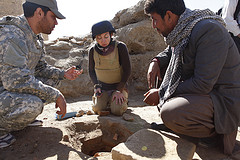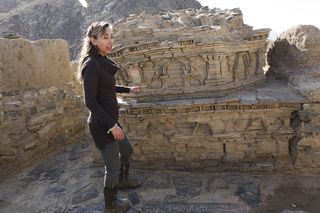By Humaira
Just when the market is flooded with books written about Afghanistan then a new and interesting book appears on the scene. This summer it happens to be A Fort of Nine Towers, written by an Afghan author, Qais Akbar Omar who mastered English by watching television and reading books while running his carpet factory in Kabul.
The Afghan diaspora is full of amazing, heartbreaking and tragic stories. When I picked up A Fort of Nine Towers it was with an element of jadedness. Qais starts his memoir in 1992, just when the Mujahideen take over Kabul and he walks us through his family’s ten-year struggle to leave war-ravaged Afghanistan for the safety of another country. He shares his family's astonishing and harrowing adventures with grace, frankness and resilience, which kept me turning the pages late into the night.
At times, after several unbelievably horrific scenes I put the book down thinking I couldn't go on reading. After a day of reprieve, I reminded myself that the characters in the book are real people and the author has personally endured these horrors. If he survived these experiences then I can continue on, which I am glad I did.
Qais is a brave and poignant storyteller who takes us on a journey that should not be missed. If you have an ungrateful teenager on your hands get them copy of A Fort of Nine Towers. I guarantee that their view of life will change for the better after reading this book. Qais has been on a multi-city book tour with many speaking engagements. I am pleased that he took the time to answer my questions which I hope will help you get to know this remarkable young man.
Humaira Ghilzai of Afghan Cultured Unveiled interviews Afghan author, Qais Akbar Omar
Humaira: Did you collaborate with your family members in order to remember the vivid details of your family's adventures?
Qais: Yes, of course. I was not intending to publish A FORT OF NINE TOWERS. It all started when 9/11 happened, and foreigners from all over the world poured into Afghanistan. They often asked me questions about what it was like to live during the years of civil war and the Taliban. When I talked about the past -- the things we have gone through -- I stopped having nightmares that haunted me in my sleep and left me shattered for days. But I could not find enough people to tell my stories and ease the pain on my soul. Some foreign friends suggested that I should write them down. Once I tried to write them in Dari, but I could not do it. I have a lot of sentimental attachment to Dari.
In 2006, I tried to write it in English. It was not so hard. I used English language as a tool, a language that I do not have a lot in common with. In the translation process in my head, the level of anguish decreases, which makes it easier for me to write about these things in English. I wrote the whole book in two months, during which I hardly walked out of the house. My mother often came to my bedroom at two or three in the morning, sat on the edge of my bed while I could not stop the tears rolling out of my eyes. She often asked me what I was writing about. I would tell her. Then she would remind me of a sweet moment. All the beautiful and happy parts are her contribution to A FORT OF NINE TOWERS. She helped me a great deal.
Humaira: In A Fort of Nine Towers you have a little bit of a sibling rivalry with your older sister. How does she feel about your portrayal of her in your book?
Qais: She is an architect with a handsome son, and she is my best friend. We had our fights as kids, like kids everywhere. She often teased me and still does whenever she has her chance. I told her about what I have written about her before A FORT OF NINE TOWERS getting published. She laughed and told me I was silly, and then she gave me a big kiss on my forehead. Even though she is less than two years older than me, but she is like a second mother to me, and my best friend in the world.
Humaira: Would you be able to shed light on how the lives of Afghan Kochis have been affected by 34 years of war in Afghanistan?
Qais: Not very much. They still have the same culture, customs, family values, and their code of Pushtoonwali (a code of conducted practiced by some Afghan Pashtun tribes), which are respect, honor and hospitality. The only thing that has changed about them, is, that they don't travel as much as they used to. Mines all over Afghanistan limited that for them. I hope one day we get rid of the mines all over Afghanistan, so they can walk back on the footsteps of their ancestors again.
Humaira: Where is your family's carpet shop in Kabul? Do you have some tips on how someone like me can pick a good carpet?
Qais: My family carpet shop is in Kabul's, Shar-e-now district. As
for the tips, here are three things to consider:
See the back of the
carpet for the knot density. The higher the density of knots, the
better.
Vegetable
dyes. The colors are softer and can go with everything; the
color of sofa, curtains, and walls.
Bargain to a point to
make the carpet-seller sweat.
(Note: Qais couldn’t disclose the exact location of his family’s carpet shop due to safety precautions.)
Humaira: What are your favorite Afghan dishes?
Qais: Lamb kebab of course. Qabili palau, sabzi and naan. But most of all, I love the delicious Afghan fruits such as, pomegranate, apple, apricot, cherry, melon and watermelon. You can't find the taste of Afghan fruits anywhere in the world.
Humaira: Do you cook Afghan food?
Qais: Yes, I can, but I don't like my cooking. I have five sisters, who learned how to cook from our mother. They are the best cooks. So, I have very high expectation of myself when I cook. My cooking never tastes as good as my mother's and sisters'. So, I eat a lot outside since I came to the US. I miss home meals a lot. If you are as a good cook as my mother or one of my sisters, maybe you can cook me some Afghan food when I come to your city, San Francisco.
(Note: Of course I agreed to make Qais an Afghan meal if he comes to San Francisco but I am sure I am not as good a cook as his mother.)
Except where otherwise noted, all content on this blog is licensed under the Creative Commons Attribution-NonCommercial-NoDerivs 3.0 Unported license.










